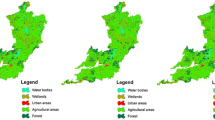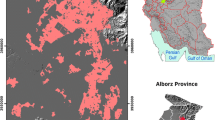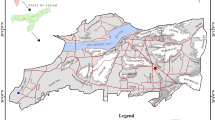Abstract
An effective and efficient planning of an urban growth and land use changes and its impact on the environment requires information about growth trends and patterns amongst other important information. Over the years, many urban growth models have been developed and used in the developed countries for forecasting growth patterns. In the developing countries however, there exist a very few studies showing the application of these models and their performances. In this study two models such as cellular automata (CA) and the SLEUTH models are applied in a geographical information system (GIS) to simulate and predict the urban growth and land use change for the City of Sana’a (Yemen) for the period 2004–2020. GIS based maps were generated for the urban growth pattern of the city which was further analyzed using geo-statistical techniques. During the models calibration process, a total of 35 years of time series dataset such as historical topographical maps, aerial photographs and satellite imageries was used to identify the parameters that influenced the urban growth. The validation result showed an overall accuracy of 99.6 %; with the producer’s accuracy of 83.3 % and the user’s accuracy 83.6 %. The SLEUTH model used the best fit growth rule parameters during the calibration to forecasting future urban growth pattern and generated various probability maps in which the individual grid cells are urbanized assuming unique “urban growth signatures”. The models generated future urban growth pattern and land use changes from the period 2004–2020. Both models proved effective in forecasting growth pattern that will be useful in planning and decision making. In comparison, the CA model growth pattern showed high density development, in which growth edges were filled and clusters were merged together to form a compact built-up area wherein less agricultural lands were included. On the contrary, the SLEUTH model growth pattern showed more urban sprawl and low-density development that included substantial areas of agricultural lands.











Similar content being viewed by others
References
Alderwish AM, Almatary HA (2011) Hydrochemistry and thermal activity of Damt region, Yemen. Environ Earth Sci (Article on-line first available). doi:10.1007/s12665-011-1192-8
Allen J, Lu K (2003) Modeling and prediction of future urban growth in the Charleston Region of South Carolina: a GIS-based integrated approach. Conserv Ecol 8(2):2. (Online) URL:http://www.consecol.org/vol8/iss2/art2
Al-shalabi M, Pradhan B, Billa L, Mansor S, Althuwaynee OF (2012) Manifestation of remote sensing data in modeling urban sprawl using the SLEUTH model and Brute Force calibration: a case study of Sana's city, Yemen. J Indian Soc Remote Sens. doi:10.1007/s12524-012-0215-6
Bathrellos GD, Skilodimou HD, Kelepertsis A, Alexakis D, Chrisanthaki I, Archonti D (2008) Environmental research of groundwater in the urban and suburban areas of Attica region, Greece. Environ Geol 56(1):11–18
Bathrellos GD, Kalivas DP, Skilodimou HD (2009) GIS-based landslide susceptibility mapping models applied to natural and urban planning in Trikala, Central Greece. Estud Geol 65(1):49–65
Bathrellos GD, Gaki-Papanastassiou K, Skilodimou HD, Papanastassiou D, Chousianitis KG (2012) Potential suitability for urban planning and industry development using natural hazard maps and geological–geomorphological parameters. Environ Earth Sci 66(2):537–548
Batty M (1997) Cellular automata and urban form: a primer. JAPA 63(2):266–274
Batty M (2000) Editorial: less is more, more is different: complexity, morphology, cities, and emergence. Environ Plann B27:167–168
Batty M, Xie Y (1997) Possible urban automata. Environ Plann B 24:175–192
Biro K, Pradhan B, Buchroithner MF, Makeschin F (2011) An assessment of land use/land-cover change impacts on soil properties in the northern part of Gadarif region, Sudan. Land Degrad Dev (article on-line first available). doi:10.1002/ldr.1116
Brail RK, Klosterman RE (eds) (2001) Planning support systems: integrating geographic information systems, models and visualization tools. ESRI Press, Redlands
Candau J (2002) Temporal calibration sensitivity of the SLEUTH urban growth model, master’s thesis. Department of Geography, University of California, Santa Barbara
Cecchini A, Rinaldi E (1999) The multi-cellular automaton: a tool to build more sophisticated models. A theoretical foundation and a practical implementation. In: Rizzi P (ed) Computer in urban planning and urban management 6th international conference. Milano, Franco Angeli
Clarke KC, Gaydos L (1998a) Loose coupling a cellular automaton model and GIS: long-term growth prediction for San Francisco and Washington/Baltimore. Int J Geogr Inf Sci 12(7):699–714
Clarke K, Gaydos L (1998b) Loose-coupling a cellular automaton model and GIS: long-term urban growth prediction for San Francisco and Washington/Baltimore. Int J Geogr Inf Sci 12(7):699–714
Clarke KC, Hoppen S, Gaydos L (1997) A self-modifying cellular automaton model of historical urbanization in the San Francisco Bay area. Environ Plann B24:247–261
Couclelis H (1985) Cellular worlds: a framework for modelling micro-macro dynamics. Environ Plann B1:585–596
Couclelis H (1997) From cellular automata to urban models: new principles for model development and implementation. Environ Plann B 24(2):165–174
Daniels T (1999) When city and country collide: managing growth in the metropolitan fringe. Island Press, Washington
De Abreu ASS, Filho OA (2011) Engineering geological data in support of municipal land use planning—a case study in Analândia, southeast Brazil. Envrion Earth Sci (Article on-line first available). doi:10.1007/s12665-011-1089-6
Engelen G, White R, Uljee I (1997) Integrating constrained cellular automata models, GIS and decision support tools for urban planning and policy making. In: Timmermans HPJ, Spon EFN (eds) Decision support systems in urban planning. London, pp 125–155
ESCWA (2007) Regional campaign on secure housing and land tenure and good urban governance, 2003–2006. http://www.escwa.org.lb/rcshltgug/doc/editoradmin/frame3.pdf
Esnard AM, Yang Y (2002) Descriptive and comparative studies of the 1990 urban extent data for the New York metropolitan region. URISA J 14:57–62
Geertman S, Stillwell J (2004) Planning support systems: an inventory of current practice. Comput Environ Urban 28:291–310
Goldstein NC, Candau JT, Clarke KC (2004) Approaches to simulating the March of bricks and mortar. Comput Environ Urban 28:125–147
Herold MG, Menz G, Clarke KC (2001) Remote sensing and urban growth models. Demands and perspectives. In: Juergens C (ed) Proceedings of the symposium on remote sensing of urban areas. Regensburg
Hurskainen P, Pellikka P (2004) Change detection of informal settlements using multi-temporal aerial photographs—the case of Voi, Se-Kenya. In: Proceedings of the 5th African association of remote sensing of environment conference, Nairobi
Jabbar MT, Zhou X (2011) Eco-environmental change detection by using remote sensing and GIS techniques: a case study Basrah province, south part of Iraq. Environ Earth Sci 64(5):1397–1407
Jantz CA, Goetz SJ, Shelley MK (2004) Using the SLEUTH urban growth model to simulate the impacts of future policy scenarios on urban land use in the Baltimore -Washington metropolitan area. Environ Plann 31(2):251–271
Kaya S, Curran PJ (2006) Monitoring urban growth on the European side of the Istanbul metropolitan area: a case study. Int J Appl Earth Obs 8:18–25
Leao S, Bishop I, Evans D (2004) Spatial–temporal model for demand allocation of waste landfills in growing urban regions. Comput Environ Urban 28:353–385
Li X, Yeh AGO (2002) Neural-network-based cellular automata for simulating multiple land use changes using GIS. Int J Geogr Inf Sci 16(4):323–343
Lv Z, Wu Z, Wei J, Sun C, Zhou Q, Zhang J (2011) Monitoring of the urban sprawl using geoprocessing tools in the Shenzhen Municipality, China. Environ Earth Sci 62(6):1131–1141
Panagopoulos GP, Bathrellos GD, Skilodimou HD, Martsouka FA (2012) Mapping urban water demands using Multi-Criteria Analysis and GIS. Water Resour Manag 26(5):1347–1363
Pedro C, Zamyatin A (2006) Three land change models for urban dynamics analysis in Sintra-Cascais area. In: Proceedings of the 1st EARSeL workshop of the SIG urban remote sensing. Humboldt-Universität zu, Berlin
Peng J, Xu Y, Cai Y, Xiao H (2011) Climatic and anthropogenic drivers of land use/cover change in fragile karst areas of southwest China since the early 1970 s: a case study on the Maotiaohe watershed. Environ Earth Sci 64(8):2107–2118
Pettit C, Shyy TK, Stimson R (2002) An on-line planning support system to evaluate urban and regional planning scenarios. In: Geertman S, Stillwell J (eds) Planning support systems in practice. Springer, Heidelberg
Pradhan B (2011) Use of GIS based fuzzy relations and its cross application to produce landslide susceptibility maps in three test areas in Malaysia. Environ Earth Sci 63(2):329–349
Rozos D, Bathrellos GD, Skillodimou HD (2011) Comparison of the implementation of rock engineering system and analytic hierarchy process methods, upon landslide susceptibility mapping, using GIS: a case study from the Eastern Achaia County of Peloponnesus, Greece. Environ Earth Sci 63(1):49–63
Samat N (2005) Validating the performance of GIS-based cellular automata spatial model: a case of Seberang Perai Penang, Malaysia. Jawatan Kuasa Pemetaan Dan data spatial Negara, Bil.1
Shaibi Al, Yahia M, Larbi H (2006) Sana’a city: medium to long-term city development strategy for sustainable development. Development Institute (AUDI), Arab Urban
Silva EA, Clarke KC (2002) Calibration of the SLEUTH urban growth model for Lisbon and Porto, Portugal. Comput Environ Urban 26:525–552
Singh AK (2003) Modelling land use land cover changes using cellular automata in a geo-spatial environment. Master thesis, ITC
Takeyama M, Couclelis H (1997) Map dynamics: integrating cellular automata and GIS through geo-algebra. Int J Geogr Inf Sci 11(1):73–91
Wagner D (1997) Cellular automata and geographic information systems. Environ Plann 24:219–234
Watkiss BM (2008) The Sleuth urban grow model as a forecasting and decision making tool. MSC Thesis, The University of Stellenbosch. Online at: http://www.ncgia.ucsb.edu/projects/gig/Repository/references/SLEUTHPapers_Nov24/Watkiss,%20BM.pdf
White R, Engelen G (1993) Cellular automata and fractal urban form: a cellular modelling approach to the evolution of urban land use pattern. Environ PlannA 25:1175–1199
White R, Engelen G (1994) Urban systems dynamics and cellular automata: fractal structures between order and chaos. Chaos Soliton Fract 4(4):563–583
Wu F (1996) A linguistic cellular automata simulation approach for sustainable land development in a fast growing region. Comput Environ Urban 20(6):367–387
Wu N, Silva EA (2009) Integration of genetic agents and cellular automata for dynamic urban growth modeling. Online at: http://www.geocomputation.org/2009/PDF/Wu_and_Silva.pdf
Xi F, Hu Y, Hung S, Wu X, Bu R, Chang Y, Liu M, Yu J (2009) Simulate urban growth based on RS, GIS, and SLEUTH model in Shenyang-Fushun metropolitan area northeastern China. 2009 Urban Remote Sensing Joint Event. Online at: http://www.ncgia.ucsb.edu/projects/gig/Repository/references/SLEUTH/shenyang-fushun,%20china.pdf
Yang X, Lo CP (2003) Modeling urban growth and landscape change in the Atlanta metropolitan area. Int J Geogr Inf Sci 17:463–488
Yeh AGO, Li X (2001) A constrained CA model for the simulation and planning of sustainable urban forms by using GIS. Environ Plann 28(5):733–753
Youssef AM, Pradhan B, Tarabees E (2011) Integrated evaluation of urban development suitability based on remote sensing and GIS techniques: contribution from the analytic hierarchy process. Arabian J Geosci 4(3–4):463–473
Zeug G, Eckert S, Steiner U, Kukuk T, Ehrlich D (2006) Monitoring urban growth and its impact on the environment: the case of Sana’a, Yemen. In: Ehlers et al. (eds) Proceedings digital earth summit on geoinformatics 2008, pp 206–211
Acknowledgments
The study benefited from the academic scholarship provided by the Ministry of Higher Education Yemen. Authors are also very thankful for the support given by various ministries and departments in Yemen with the provision of data and other information used in the study. Thanks to two anonymous reviewers for their useful comments on the earlier version of the manuscript.
Author information
Authors and Affiliations
Corresponding author
Rights and permissions
About this article
Cite this article
Al-shalabi, M., Billa, L., Pradhan, B. et al. Modelling urban growth evolution and land-use changes using GIS based cellular automata and SLEUTH models: the case of Sana’a metropolitan city, Yemen. Environ Earth Sci 70, 425–437 (2013). https://doi.org/10.1007/s12665-012-2137-6
Received:
Accepted:
Published:
Issue Date:
DOI: https://doi.org/10.1007/s12665-012-2137-6




